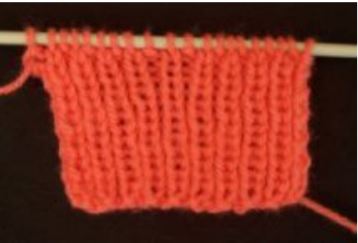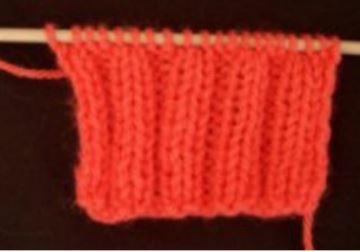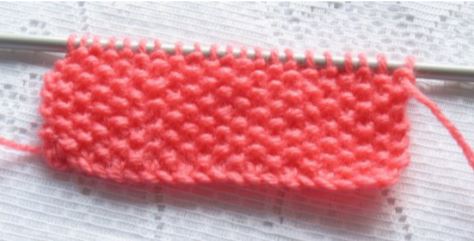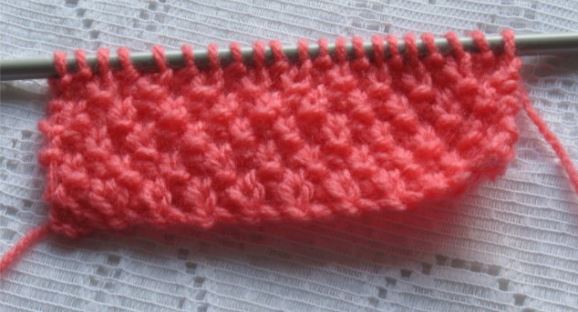Included below is a small sample of different stitch designs. These are some of the most common and my favorite stitch designs that are possible with simple knit and purl stitches. I suggest you practice the designs here and then experiment or check out one of the excellent books available with many, many more stitch designs. My personal favorite book is The Knitter’s Bible by Claire Crompton available on Amazon.
Ribbing
Ribbing is created by alternating columns of knit and purl stitches, usually 1×1 or 2×2. It is springy and elastic and is used for the waist, cuffs and neckbands of jumpers and for hats.
Tip: Knit thin elastic thread in with your yarn for ribbing cuffs.
K1, p1 rib
This is also known as single rib and is normally worked over an odd number of stitches. Knit the first stitch with yarn at the back Purl the second stitch (remember to bring the yarn to the front for the purl) Repeat along the row to the last stitch, which should be knitted That will set the pattern for the rib. On the next row just knit the knit stitches and purl the purl stitches. Repeat in this manner until you have ribbed as many rows as required.

K2 p2 rib
Cast on an even number of stitches, usually a multiple of 4 plus 2. A multiple of 4 stitches will mean that the front of the work starts with 2 knits and ends with 2 purls. A multiple of 4 stitches + 2 extra stitches will ensure that both edges of the work are columns of 2 knits.
Knit 2, purl 2 all the way along to the end. This sets the pattern for the rib. On the second and subsequent rows knit the knits and purl the purl stitches until you have completed as many rows as required.

Tip: When knitting a new complicated pattern for the first time have another knitter read the instructions out loud to you as you work through the steps. This avoids you misreading and helps you understand because you hear the instructions, which often helps unblock a difficult passage.
Textured Knitting
With the knowledge of how to knit and purl there are now a huge variety of textures that you can knit.
The stitches known as moss stitch and double moss stitch are often used as interesting background stitches on Aran type garments. They are very easy to knit and are based on k1, p1 rib.
Moss Stitch / Seed Stitch
Cast on an odd number of stitches or work over an odd number of stitches.
- Row 1: K1, *p1, k1 repeat from * to end of row
- Repeat this row as often as required. You will always be knitting the purls and purling the knits as you work.
If you have an even number of stitches:
- Row 1: K1, *p1, k1 repeat from * to end of row
- Row 2: P1, *k1, p1 repeat from * to end of row
- Repeat these two rows. Again, you will always be knitting the purls and purling the knits as you work.

Double moss stitch / Double seed stitch
When knitting double moss stitch you knit 2 rows of k1, p1 rib and then change over so that you are knitting p1, k1 rib. Every front row knit the purls and purl the knits; every back row you knit the knits and purl the purls.
With an odd number of stitches:
- Row 1: k1, *p1, k1 repeat from * to end of row
- Row 2: p1, *k1, p1 repeat from * to end of row
- Row 3: as row 2
- Row 4: as row 1
- These 4 rows are then repeated as often as necessary.
With an even number of stitches:
- Row 1: *k1, p1 repeat from * to end of row
- Row 2: as row 1
- Row 3: *p1, k1 repeat from * to end of row
- Row 4: as row 3
- These 4 rows are then repeated as often as necessary

There are hundreds of different textured patterns that can be created by a combination of knit and purl stitches.
